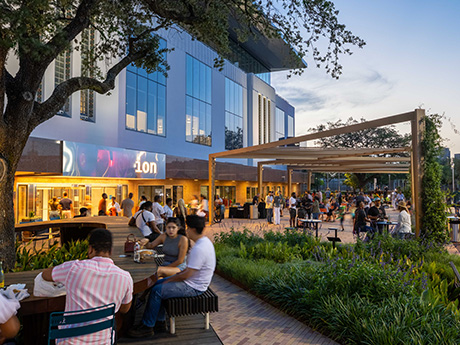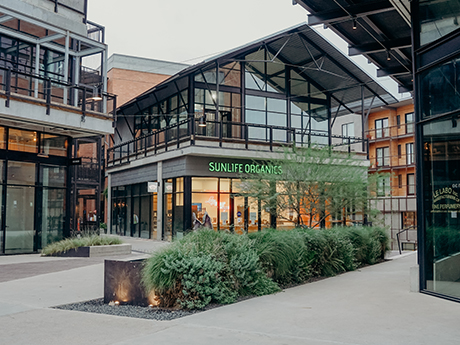By Burdette Huffman, executive vice president, Blue Ox Group
Why are people drawn to spend money and time at certain places in a city? What makes someone want to do their shopping, stop for coffee or plan a date night at one spot versus another?
Sometimes, it’s a special location or an emotional connection to a particular vendor. But in many instances, the draw is entirely by design. It’s an intentional, strategic urban planning tactic that’s been around for decades, and it’s called placemaking.
What Is Placemaking?
The concept of placemaking has been around since the 1960s thanks to urban planning pioneers and was bolstered in the 1990s by the smart growth agenda of organizations like the Urban Land Institute. In modern parlance across the state, it’s not much different. Put simply, placemaking is about creating a special place where people want to be.

Placemaking is about imagining and then developing a place where parents might want to grab coffee after dropping their kids off at school. Or it’s a place where date nights happen because there’s a great new spot for dinner and maybe space to take a walk or grab a drink afterward. If it’s executed correctly, it’s the very same place where the kids want to get dropped off over the weekend to hang out with their friends. It’s usually highly walkable, unique in design and connected to a number of things. And most important, placemaking always has some type of humanistic connection at the ground level, or human plane.
Even in a city like New York that’s dense with buildings, placemaking is at work, helping certain districts feel approachable rather than cold and concrete. You can walk through an entire neighborhood that’s crammed with skyscrapers. But if the ground plane feels like it has a lot of connectivity with storefronts, cafes and plazas, then people feel connected.
That human connectivity is crucial to placemaking. Even the most beautiful, high-end projects feel sterile if they lack a sense of connectivity. Simply arranging some café chairs outside with tables doesn’t work. Even the right lighting can make or break a space, helping it to feel welcoming and warm instead of sterile and cold.
Restaurants, for example, have to be particularly careful to ensure that diners won’t feel like they’re sitting outside in an exposition situation, almost as if they’re on display for passersby. Nice umbrellas, good air movement, plenty of shade and greenery shift the dynamic to a place that diners want to be — and stay. In this sense, patios are a great example of micro placemaking.
What Makes Placemaking Work?
Lush landscaping and proper lighting are paramount. But successful placemaking is a combination of many ingredients, some of which need to be incorporated into plans way ahead of development and negotiated via partnerships in brokerage. Just as important as wide sidewalks and strong walkability are a range of exciting storefronts that people can engage in and be a part of. These aren’t afterthoughts once the space is leased. These are considerations for the leases themselves.
From a retail standpoint, landlords should provide a canvas for tenants to do something exciting with their spaces. If you were to walk along the full length of the exterior of the Galleria Mall in Houston, it’s extremely boring since there’s nothing happening on the outside of the building. But if you were to take the same walk inside the mall, it’s actually very interesting. There are plenty of things to look at, from storefronts to merchandise. There are smells; there are sounds. Even though the walk inside might be the same distance as the walk outside, it’s a completely different experience because of all of the eye candy. This is placemaking in action.
In terms of urban retail developments, successful placemaking means providing the right combination of cool storefronts, interesting merchandise and attractive dining options, complemented by unique architecture that relates to the human scale.
The Power of Mixed-Use
Since one of the most important signs of successful placemaking is pedestrian traffic, ensuring round-the-clock footfall is key. The goal is steady, quality traffic from morning until night, ideally without any long gaps in activity.
Strategic development can ensure healthy traffic. For example, fitness studios drive traffic in early mornings and afternoons. Hotels and apartments create quality traffic on weekends when office-centric developments might otherwise appear barren. Conversely, offices ensure heavy traffic during weekdays and lunch hours.
Beyond a steady flow of foot traffic, considering parking flows is key. Though it’s one of the least sexy parts of placemaking, it’s very important, and mixed-use can help solve it. Remember: Parking doesn’t have to always be available right front and center; it just needs to be accessible. Mixed-use developments naturally fuel quality traffic and, in turn, quality parking flows.
Why is the mix of uses so important? Because single-use results in low traffic. If a development is built solely around a movie theater or a concert venue, it draws people (and their cars) to just one venue at one time, after which they take off, leaving the space vacant. Alternatively, good placemaking attracts people to stay for multiple reasons, and that’s achieved through mixing uses.
When given a choice, people typically want to spend time in places with more than one offering — a place where they can go shopping, go to dinner and maybe catch a movie at some point along the way, rather than going out of the way for each activity.
Placemaking Role Models
Strategic placemaking can succeed in any number of urban situations. In Plano, Legacy West works because it features architecture with variation built into the mix. Beyond a great walkability factor and a good location within the city, it also has a strong tenant mix. There’s a blend of restaurants, soft goods as well as hard goods, and there’s retail worth driving to — places that are unique to the area rather than the big boxes of Anywhere, USA.
Rice Village in Houston is another great example of placemaking that is anchored in a strong tenant mix that can’t be replicated anywhere else. That development’s two fine dining restaurants, Hamsa and Navy Blue, were both featured on Texas Monthly’s list of “Best New Restaurants” the year they opened. In addition, they are both single-location restaurants in the state of Texas, meaning they can only be experienced at Rice Village. Similarly, though it’s a national chain, CB2’s only Houston location is at Rice Village. When you start to put together a merchandising mix, curating unique tenants and popular national retailers without nearby locations gives people a reason to seek out a development and then stay a while.
Another great example is South Congress in Austin. There’s consistently a steady flow of traffic, both pedestrian and vehicular. This is because the area has a blend of great restaurants, shopping, coffee shops, hotels and residential buildings. Once you combine all of those things, you get the kind of quality traffic that can make or break urban developments.
The historic Pearl District in San Antonio, which is centered around a revived brewery building, is another successful example of strategic placemaking. It was a defined transition of a brewery that had ceased to operate in 2001, and its redevelopment invigorated the entire section of San Antonio, which at the time was falling into neglect. Now, it’s thriving.
Parallel to Pearl is Houston’s Ion District, which also revived a large, older building with strategic placemaking. In that case, the anchor property is the former Sears department store, built in 1939 and closed in 2018. Microsoft and Rice University are key tenants, and a mix of uses is being fleshed out with a theater complex, destination restaurants, residential housing and offices. Each is important to bringing cohesiveness and harmony, both from a placemaking standpoint and engaging a wide variety of stakeholders in Houston.

Larger Draws, Larger Equity
The most successful placemaking doesn’t just draw people from within the immediate neighborhood. It draws from other regions and can even serve as a destination. This can happen when the right blend of community stakeholders are involved in a given development and brought into the placemaking conversation.
Houston’s Rice Village example works on this level because it draws multi-generational traffic, from young teens walking around on the weekends to middle-aged and younger working communities, all the way up to an older crowd. It also pulls crowds from different parts of the city — from Pearland, Memorial, River Oaks — and people visit from five and 10 miles away, and sometimes even further.
This kind of regional draw eventually raises the value of the homes from both an economic and a non-economic standpoint; having a great retail hub within the community raises its perceived value, and people naturally want to live closer to amenities. Eventually, that translates to stronger growth on the periphery of whatever’s happening within the placemaking.
For example, a restaurant that’s a block away from a great placemaking space may end up thriving simply by proximity. San Antonio’s Pearl District is a good example of this. In the years immediately after the brewery shuttered, there wasn’t a lot of growth or economic vibrancy. People didn’t want to live there. Now, there are brand new apartments and restaurants not only in the placemaking project, but also surrounding it.
There are plenty of other examples of great placemaking throughout the state, from Highland Village and Knox-Henderson in Dallas to Domain North in Austin to the Woodlands and Uptown Park in Houston.
Key to every single one of these spaces are two things: incorporating space outdoors and built-in interactions with other humans. From there, the possibilities are endless. Places that succeed the most offer exquisite experiential environments, art installations or spaces that push the envelope of what it means to be a retail or dining space.


